An Open Letter to David Redl Upon His Confirmation as NTIA Administrator

Congratulations on your appointment and confirmation as Assistant Secretary of Commerce for Communications and Information/NTIA Administrator! NTIA has many responsibilities, but this post will focus on its spectrum management ones - a key issue in our increasingly spectrum-dependent world. On behalf of the President, NTIA administers his jurisdiction for use of the spectrum by federal agencies. But in reality the "elephant in the room" is the Interdepartment Radio Advisory Committee (IRAC) whose origin goes back to the 1920s.
While Title IX of the Communications Act which codifies NTIA's establishment barely mentions IRAC, the role of IRAC is as mysterious are the role of the Politburo in the former Soviet Union. Does IRAC "advise" NTIA or does IRAC actually make most of the decisions with occasional oversight from NTIA when either Congress gets interested or a private sector entity has enough political power?
I would urge you to read Nobelist Ronald Coase's report "Problems of Radio Frequency Allocation" which was written in the early 1960s but suppressed for about 30 years. In particular, I suggest you review the IRAC and FCC discussion on p. 44-72 (pdf p.52-80). While this material was written decades before the creation of NTIA and several years before even the creation of the former OTP, where the late Justice Scalia served, to many of us it is the best description of IRAC practices that exists in the public domain. The report has citations to hearing and reports on spectrum management going back to WWII. It reveals (p. 59, pdf. p. 66) that as early as 1950 legislation was introduced to create an independent agency in the federal government to "formulate plans and policies for the utilization of spectrum".
I was privileged to have a discussion with the late Justice Scalia about 5 years ago on how federal spectrum management worked in OTP days. (There are a few other OTP veterans still active in the field, so I urge you to reach out to them for insight.) While OTP Director Whitehead let IRAC handle many functions, he was willing to and actually did intervene much more than NTIA has in recent decades. In particular, he was willing to call cabinet members directly to get them to reverse positions their agencies had taken in IRAC - generally without knowledge of top agencies officials in a "deep state"-like arrangement.
Of course, Whitehead's White House phone number helped a lot! While the 2012 PCAST spectrum report may be falling out of favor in the current Administration, I urge you to review Section V which is not controversial and particular Recommendation 5.1 on increasing the White House role in spectrum policy:

After the PCAST report there was a slightly increase spectrum policy presence in the White House with the detail of an NTIA middle manager to OSTP. Due to budget constraints, this OSTP specialist was actually paid by NTIA and was expected to return there. The White House needs more of a point person on spectrum policy and this is important enough that person should be independent of BOTH FCC and NTIA.
The NTIA spectrum staff seem to think that they can't really regulate other federal agencies and that no other agency can regulate such agencies in any matter. Let me point out some examples:
- EPA regulates pollution from federal agency activities
- OSHA regulates federal workplace safety
- GSA regulates federal real property (e.g. buildings and land)
- NRC regulates nonweapons related federal use of radioactive material
- OPM regulates federal personnel policies
- NSA regulates federal agency use of encryption
Early in my FCC career I used to periodically attend IRAC meetings and as well as meetings of an interagency committee at NSA that dealt with federal encryption equipment and its use. In both cases the groups were discussing policies that would apply to the agencies present. The key different was that IRAC thought they could make decisions based solely on the consensus of those present and that that broader "public interest" did not explicitly matter since the IRAC members were all public employees! In the NSA group it was clear that NSA was in charge and had a charter from POTUS but wanted to hear and consider the views of affected agencies. BIG DIFFERENCE!
Both NTIA and FCC really are understaffed with people who can do independent technical review of spectrum sharing issues, particularly novel ones. Thus you might want to consider this recommendation from IEEE-USA on creating a new advisory committee to both FCC and NTIA of technical experts without industry ties who can look independently at technical issues of spectrum sharing and interference and suggest possible solutions to difficult problems to both agencies. Since the physics is the same from both G and NG radio signals it makes sense to have on committee serve both and would save money since nonindustry advisory board members must get paid for their time..
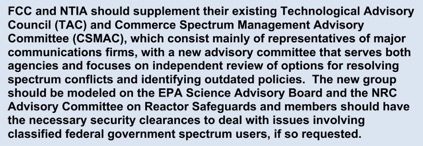
(Note that since this was drafted last year the EPA SAB has changed significantly and has become controversial.
However, the NRC group still has the same structure.)
So Mr. Redl, congratulations and let's hope that you can take an open minded approach to finding a new clarification on the relative roles of IRAC and NTIA in managing spectrum.
Update on PCAST Report on Federal Spectrum & Sharing
Video streaming by Ustream
On Friday, April 4, New American Foundation hosted a distinguished set of speakers on the PCAST spectrum report, including several of its authors. Here is a list of speakers:
- Jason Furman - Chair, President’s Council of Economic Advisors
- Tom Power - Deputy CTO for Telecommunications, White House Office on Science and Technology Policy
- John Leibovitz - Deputy Bureau Chief, Wireless Telecommunications Bureau and Spectrum Advisor to the Chairman, FCC
- Craig Mundie - Member, President’s Council of Advisors on Science and Technology (PCAST) and Senior Advisor to the CEO, Microsoft Corporation
- Mark Gorenberg - Member, President’s Council of Advisors on Science and Technology (PCAST) and Founder and Managing Director, Zetta Venture Partners
- Milo Medin - Vice President of Access Services, Google Inc., and Invited Expert, PCAST
Above is the video of the event. Of particular interest is the talk by Tom Power on implementation of PCAST (00:06:30 - 00:26:00) and an excellent talk by Jason Furman of the economic importance to getting spectrum policy right - a topic rarely discussed. (0:26:34 - 00:53:00).
Your blogger is humbled by the kind words of PCAST member Mark Gorenberg at 01:18:40.
2 Unsual Places Ask for Comments on US Spectrum Policy
The OSTP request was published in February in the Federal Register and announced on the OSTP website on February 14, 2014 in a blog post by Tom Power, U.S. Deputy Chief Technology Officer for Telecommunications. Also released at the same time was a report by the IDA Science and Technology Policy Institute (a “think tank dedicated to OSTP operated by your blogger’s former employer - many years ago - IDA) entitled “A Review of Approaches to Sharing or Relinquishing Agency-Assigned Spectrum”. The request comes from the White House “Spectrum Policy Team”, a sort of virtual recreation of the spectrum functions of the old White House Office of Telecommunications Policy was recommended in the 7/12 PCAST spectrum policy. The team was created by the Presidential Memorandum of 6/14/13 and consists of
The 6/14/13 memorandum told the team to “monitor and support advances in spectrum sharing policies and technologies” and told NTIA to “consult” with the team on various details of implementing the memorandum. Readers may recall that at the time of the memorandum, this blog speculated that the team might be the “adult supervision” that NTIA and IRAC have long needed (in our view) to bring federal agency spectrum policy more inline with national goals. (Up until 1978 spectrum policy oversight was based in the White House and the White House staff served as a check on whether IRAC actions really served national goals. With the creation of NTIA in 1978, the head of NTIA - an assistant secretary of Commerce - lacked the “clout” and direct access to key White House staff to reliably keep agencies in line if they became parochial.)“The Chief Technology Officer and the Director of the National Economic Council, or their designees, shall co-chair a Spectrum Policy Team that shall include representatives from the Office of Management and Budget (OMB), the National Security Staff, and the Council of Economic Advisers. The Spectrum Policy Team shall work with NTIA to implement this memorandum. The Spectrum Policy Team may invite the FCC to provide advice and assistance.”
The IDA report addresses “nine major approaches to providing incentives to Federal agencies to share or relinquish assigned spectrum”. Six of these are market-based approaches, e.g. spectrum fees or agency property rights, while the last three are directed reallocation and sharing approaches. The following chart summarizes the options:
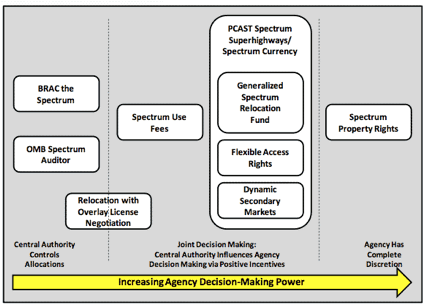
The comment date on this request has now passed and the the comments are now available here. (Due to a clerical error, when this is being posted CTIA’s comments are missing from the consolidated .pdf file this links to. OSTP is aware and working to correct this.) Basically all the comments favor the economic approaches except for Lockheed Martin, a card carrying member of the military industrial complex, who says user fees are bad idea and prefer a “Spectrum Innovation Fund for federal users and says that “incentives to share spectrum must promote the employment of innovative technologies by federal agencies”.

The House Energy & Commerce Committee, presumably the Republican majority given our dysfunctional Congress, released on 4/1/14 a white paper on spectrum policy. The Committee seeks comments saying,“(w)hile the questions posed in this white paper address specific spectrum issues, the committee encourages interested parties to comment on any aspect of spectrum policy. Responses should be submitted to CommActUpdate@mail.house.gov by April 25, 2014.” They are also using the Twitter hashtag #CommActUpdate to stimulate discussion. The white paper deals with 10 basic areas, most with 1-2 questions. Some overlap with the OSTP document, for example “What should be done to encourage efficient use of spectrum by government users?”
The IDA report and OSTP makes interesting reading and are strongly recommended. The House committee questions also are thought provoking. We hope readers will comment on them.
CTIA Can Be as Rigid as NRA is on Gun Control
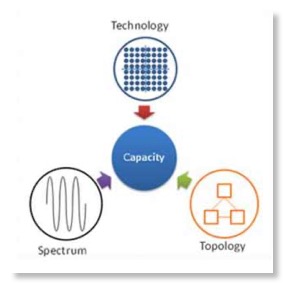
And where will this new spectrum come from? Wireless Week writes
“Largent stressed the need for the FCC, as well as the President, to pressure government agencies like the Department of Defense, to clear unused spectrum for commercial use. ‘It's really hard to pry this spectrum out of their hands...It's incumbent on the president and the FCC to pressure them to give up some of this spectrum’ ”
Largent’s staff then tried to outdo their boss on rigidity.
“Chris Guttman-McCabe, CTIA's vice president of regulatory affairs, made it clear that spectrum sharing is not the end goal, noting that the report from the President's Council of Advisors on Science and Technology (PCAST), which recommended sharing airwaves a matter of policy did not have adequate input from the wireless industry. "There were no infrastructure vendors, no handset vendors at the time and no carriers," Guttman-McCabe said of PCAST. "We believe here, there needs to be a focus on clearing...as a fallback, we are perfectly comfortable investigating sharing...but with the goal of eventually clearing that spectrum."
So PCAST did not have any industry insiders as members. Can you imagine that the White House does not view the techies of the cellular infrastructure vendors, handset vendors and carriers as not meeting their criteria as “the nation’s leading scientists and engineers”.
As a public service, here is an extract from the PCAST report listing the PCAST members and “Invited Experts” involved in drafting it. Isn’t Largent’s predecessor Tom Wheeler there? Now sources tell me that Wheeler really wasn’t very active in drafting the report, but he certainly was in the inner circle. Isn’t Dale Hatfield, my former boss and a close friend of CTIA there also? Note that CTIA proudly posts on it website the following video of Dale saying at a CTIA conference “ we can no longer afford to sacrifice spectrum due to inefficient technology.”

At least Chris is willing to consider sharing as a “fallback”. What if it really works? Will CTIA at least consider that possibility? Is the need for readily available Chinese made equipment in all cellular bands really a key driver in spectrum policy. It is ironic that he says this as Sprint has foresworn Chinese suppliers for the core of their network.
Lest CTIA think that the evil sharing is a concept only advocated by irrational cellular industry enemies at FCC and NAB, perhaps they should review the following document from European regulators:
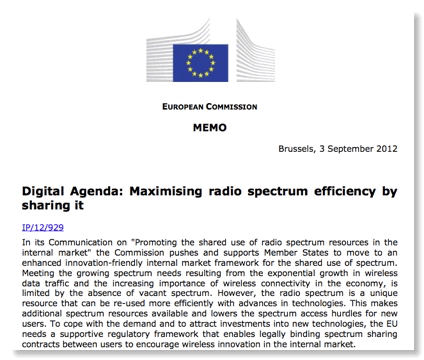
This EC memo has statements like
The radio spectrum is a finite resource – there is no vacant spectrum remaining, and the cost of re-allocating spectrum to new uses is high. On the other hand there is an exponential increase in the use of spectrum – for example driven by mobile computing devices, Wi-Fi hotspots but also smart electricity grids and industrial automation. This creates challenges for meeting the growing demand for spectrum.
However, thanks to advances in technology, it is now possible to share the spectrum more efficiently. Many new wireless technologies are designed to share bands in which no licence is required (licence-exempt bands), while others make additional spectrum resources available by, for example, providing wireless broadband services in between TV frequencies (the 'white spaces'). To maximise the benefits of spectrum sharing, regulatory barriers need to be removed and incentives provided. This requires new regulatory approaches to give different users the right to use a given frequency band on a shared basis...
The main reasons are the economic incentives to use spectrum efficiently by getting more out of the same amount of spectrum wherever technology allows it. The proposed approach is firmly based on the need to provide economic incentives for innovators and incumbents alike..
For example public entities that are incumbent right holders could offer access to spectrum capacity to commercial operators in return for co-funding of network infrastructures, for example for broadband public protection and disaster relief (PPDR) applications. Commercial operators will be able to recoup investment costs by sharing spectrum in areas or at times of the day that their spectrum is underutilised. On the other hand, innovators who can compare sharing opportunities in a competitive internal market could use economic incentives to encourage incumbents to share spectrum, if they have an innovative technology that allows it. In order to reach the economies of scale that stimulate such innovations, the EU needs a common approach in the internal market to identify beneficial sharing opportunities across the entire radio spectrum.
So sharing is not the result of anticellular industry “dark forces” lurking in Washington, it is a concept that is moving faster than the cellular industry wants it to move in order to balance using today’s technology available resources with growing capacity needs while addressing other uses of spectrum that are also valuable to societies and economies.
SECDEF Hagel & Cellular Industry
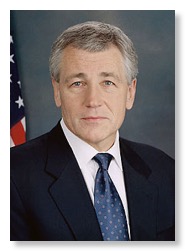
The Senate has confirmed military and wireless industry veteran Chuck Hagel as the next Secretary of Defense.
Hagel was a co-founder of Vanguard Cellular systems. At one time, Vanguard was the largest independent wireless carrier and was eventually bought by AT&T Wireless in 1999.
A little Googling revealed:
- “He left the Army in 1968 with the rank of sergeant. Hagel later co-founded Vanguard Cellular in 1984. The money he earned from the cellular carrier allowed him to enter politics on the national stage.” Military.com
- “After the war, he worked his way through the University of Nebraska in Omaha, then got a job in the office of Rep. John McCollister, R-Neb. He rose to administrative assistant; after McCollister lost a Senate race in 1976, Hagel became a lobbyist for Firestone. He later got the Number 2 position in the Reagan Veterans’ Affairs Administration, but resigned after only one year. Hagel then founded Vanguard Cellular Systems, which became the second largest cell phone company in the nation.” National Journal
FCBA Brown Bag Lunch on PCAST Report and Its Impact on Federal Spectrum Policy

Speakers: Preston Marshall, Deputy Director, Information Sciences Institute, University of Southern California and "Invited Expert" contributor to report; Larry Irving, Irving Group (Former NTIA Administrator); Christopher Guttman-McCabe Vice President, Regulatory Affairs, CTIA
This discussion will be different than previous ones int eh DC area in that the speakers have been asked not to focus explosively on the issue of sharing vs. reallocation, rather they will also discuss other key issues int he report such as receiver standards and reform of federal spectrum management. It is you blogger’s viewpoint that no substantive progress in repurposing federal spectrum through either reallocation (favored by the cellular industry) or sharing (proposed in the PCAST report) is possible without some fundamental changes in federal spectrum management.
Reservations are needed. Go here to register. (Note FCBA members are required to login, nonmembers are required to set up a guest account.)
Location: Hogan Lovells US LLP, 555 Thirteenth Street, NW (Fulbright-East conference room). Check in at the concierge desk located in the building's lobby.
Hope to see you there!
ITIF Holds 2nd Workshop on PCAST Report

Here is the description:
The President's Council of Advisors on Science and Technology (PCAST) recently issued a controversial report on spectrum policy. The report declares the current system of spectrum reallocation "unsustainable" and recommends that the sharing of raw spectrum by multiple network operators should be the new norm. The panel will explore the report's many findings and recommendations in order to answer the following questions:
What is the current system for spectrum assignment?
Is the current system sustainable?
How fast is the government's appetite for spectrum growing?
How can we best manage competing demands for spectrum in the commercial and government sectors?
Is it practical to replace exclusive licensing with a raw sharing regime?
Are there alternatives to exclusive licenses and unlicensed access?
What options will advances in technology provide to spectrum policymakers?
The speakers, in addition to your blogger, will be
Richard Bennett, Senior Research Fellow, Information Technology and Innovation Foundation
Michael Calabrese. Vice President & Director, Wireless Future Program,The New America Foundation
Preston F. Marshall
Deputy Director of the Information Sciences Institute, USC Viterbi School of Engineering
Peter Rysavy, Rysavy Research
Stephen J. Norton,Communications Director,Information Technology and Innovation Foundation, Moderator
Here is the link to signup.
FCC Schedules Action on PCAST Report
Today, FCC Chairman Julius Genachowski joined PCAST members Eric Schmidt and Mark Gorenberg at Stanford University. Specifically, he announced that the FCC will, by the end of the year, initiate formal steps to implement the key recommendations of the PCAST report, including small cell use in the 3.5 GHz band. Freeing up spectrum in this band will add 100 megahertz to our nation’s wireless broadband networks.
FCC Chairman Julius Genachowski said, “Today’s iPhone announcement and last week’s release of the new Kindle Fire, Windows 8/Nokia Phone, and Droid RAZR by Google/Motorola offer the latest evidence that, over the past few years, the U.S. has regained global leadership in key areas of communications technology. These high-performance devices, and the demands they place on our broadband networks, underscore a critical challenge.”
“Today, I announce the FCC will initiate formal steps by the end of the year to implement keyrecommendations of the President’s Council of Advisors on Science and Technology report around freeing up spectrum in the 3.5 GHz band. This action will represent a major innovation in spectrum policy that will in turn enable innovations in wireless applications throughout the economy, including energy, healthcare, education, and other uses yet to be discovered.”
Wireless Week had reported in July
FCC Commissioner Ajit Pai said he has "serious concerns about the report’s apparent dismissal of clearing and reallocating federal spectrum for commercial use."
Though "spectrum sharing has its place... I continue to believe that clearing federal spectrum bands and reallocating them for exclusive commercial use is a critical component of any sensible spectrum strategy," he said.
While CTIA has no statement as yet on the new statement by Chairman Genachowski, they indicated in July their primary interest is in reallocation of spectrum, not sharing. They stated then
.At the same time, and as Congress recognized in the recently-passed spectrum legislation, the gold standard for deployment of ubiquitous mobile broadband networks remains cleared spectrum.
Cleared spectrum and an exclusive-use approach has enabled the U.S. wireless industry to invest hundreds of billions of dollars, deploying world-leading mobile broadband networks and resulting in tremendous economic benefits for U.S. consumers and businesses
The real issue is not whether industry would prefer reallocations of federal spectrum, but rather whether that is practical in a timely way, especially considering the current arrangements for federal spectrum management. Thus while in July AT&T said
“We fully support the NTIA effort of determining which government bands can be cleared for commercial use, and we look forward to continuing to work with NTIA and other stakeholders to make more spectrum available for American consumers and businesses.”
the reality is that NTIA as presently structured is in no position to make such determinations. NTIA may have the same nominal 47 USC 305 power as the Nixon era Office of Telecommunications Policy, Larry Strickling is no Tom Whitehead! This is not because of Strickling’s intentions and competence, but serving as Assistance Secretary of Commerce he does not have the political horsepower to tell other agencies how to spend their own money on wireless systems.
It seems odd that the cellular industry, in all its griping about the PCAST report, has not made any statement on Section 5 which deals with reform of federal spectrum management. At the October 3 FCBA Engineering and Technology Practice Committee brown bag lunch in DC, one of the PCAST contributors, Preston Marshall, will speak alongside Chris Guttman-McCabe of CTIA and former NTIA Administrator Larry Irving. I will post signup details when available. Perhaps we will hear more on this issue at that time.
The PCAST report states near the beginning
PCAST finds that clearing and reallocation of Federal spectrum is not a sustainable basis for spectrum policy due to the high cost, lengthy time to implement, and disruption to the Federal mission. Further, although some have proclaimed that clearing and reallocation will result in significant net revenue to the government, we do not anticipate that will be the case for Federal spectrum.
I suspect as long as the current practices in federal spectrum management continue this will be the case. At present the IRAC is the real judge of “high cost, lengthy time to implement, and disruption to the Federal mission” and NTIA lacks the independence and resources to review these issues objectively. For example, at a House hearing today, NTIA reallocation cost/time estimates were disputed by GAO:
Mark Goldstein, director of physical infrastructure issues for the GAO, said that some of the info NTIA used to make that cost/time estimate was not accurate, and that the system it used for gathering it would not change for several years.
But there are other agencies that regulate federal government activities in a more objective way then NTIA. For example,
- OPM regulates personnel practices,
- GSA regulates real estate use,
- OSHA regulates worker safety issues,
- EPA regulates environment impact of federal agency activities,
- NRC regulates use of radioisotopes and reactors (other than those involved in weapons production), and
- NSA regulates communications security practices.
These agencies do not kowtow to their fellow agency regulatees as NTIA does - although in the NTIA case this is a result of structural weakness, not poor intent.
Federal spectrum management need a similar objective regulator that focuses on the overall national interest, not the near term interests of the IRAC members. Maybe the creation of NTIA in 1978 was reasonable at the time, but the proposals of section 5 of the PCAST report go a long way towards creating the basis for greater use of the spectrum in the public interest either through sharing or reallocation. Perhaps the cellular industry will formulate a viewpoint soon on where they stand on federal spectrum management reform and not just gripe about sharing vice reallocation.
Battling Spectrum Reports: Mobile Future vs. PCAST
On Sunday 7/15 Mobile Future released a report entitled “Spectrum Sharing: The Promise and The Reality”, almost certainly in anticipation of the final PCAST report that was released on Friday 7/20 as had been previously announced. The PCAST report was discussed here previously when a public briefing discussed its basic findings. A year ago we introduced readers to Mobile Future in a post entitled “New Cellular Advocacy Group Trivializes Spectrum Policy Issues”. Mobile Future’s membership includes Alcatel-Lucent, AT&T, Ericsson, Qualcomm, and T-Mo but not VZW and Sprint.
Mobile Future 2011 video
The cellular industry was angry at the staffing of the PCAST report because they saw it as stacked with Silicon Valley interests. However the 21 “invited experts” (p. xvii-xviii) included Dale Hatfield, who is clearly on close terms with the cellular industry, the former R&D chief of Motorola, and Tom Wheeler, former head of CTIA. It also included 13 individuals with academic affiliations, a ratio common on Japanese government advisory committees but previously unheard of in the FCC/NTIA cases.
A July 5 article in Bloomberg BNA Telecommunications Law Resource Center™ , “Despite Calls for Spectrum Sharing, Technological, Regulatory Questions Linger” contained the basic points that the Mobile Future/Rysavy report elaborated on:
While the concept has been embraced by the FCC, NTIA, and PCAST, the chief concern of the wireless industry is that spectrum-sharing technologies might not be ready for commercial application until 2020 at the earliest.
“If you come out and start saying, 'let's share spectrum,' and there's not a means for doing spectrum sharing, you've compounded the problem,” Randall Stephenson, chairman, chief executive, and president of AT&T Inc., told reporters following remarks at a Washington event in June.
Since May, Stephenson has publicly suggested twice that spectrum-sharing technology is not ready for “prime time,” while giving his general support for the idea pending the resolution of many “what ifs.”
Note that AT&T is a member of Mobile Future and you see the connection.
The Mobile Future members want sole focus of spectrum deliberations to be on reallocation to them and view sharing as academic illusion that isn’t ready for prime time. Of course, while the industry see spectrum sharing as an unimplemented illusion, it also sees 700 MHz LTE systems for nationwide public safety voice and data with priority and preemption as a straight forward engineering task. It would be interesting if Mr. Stephenson could comment on why one is so risky and the other so straight forward.
So with all this preliminary effort the final PCAST report came out today. As Mobile Future feared, it emphasizes sharing spectrum, not reallocating it entirely to the cellular industry. This is a terrible blow to the Chinese electronics industry because it means that world wide standard equipment can not be used in all bands in the US. However, the usual Chinese made equipment will still work in many bands including all the present ones. In many cases the nonstandard features to deal with sharing spectrum will be in the base stations NOT the handsets so the CTIA membership will still be able to fill their stores with Chinese products.

Rather than focusing on the inevitable bad news about sharing, the cellular industry and other nonfederal government spectrum users show focus on and praise the first real proposals in a long time to reform federal spectrum management and create the right incentives for managing the spectrum in the national interest, not in the parochial interest of IRAC members.
I suggest that the cellular industry carefully read the following recommendations of the PCAST report and realize that for the first time (since Nixon’s OTP) they offer the hope of creating a real national spectrum management system that focuses on the national interest:
Finding 5.1: There is no incentive system today for Federal Government agencies to be efficient in their use of spectrum or to share spectrum allocated to them with the non-Federal sector.
Finding 5.2: A public private partnership (PPP) is the best mechanism to ensure that optimal use is made of the Federally-held spectrum and of related investments in spectrum research and testing.
Finding 5.3: International harmonization of spectrum policies is essential to product innovation, interoperability and roaming, spectrum efficiency, and cross-border frequency coordination.
Recommendation 5.1: PCAST recommends that the White House Chief Technology Officer (CTO) with senior officials at an equivalent level from the National Security Staff (NSS), the Office of Management and Budget (OMB), and the National Economic Council (NEC) formalize a Spectrum Management Team (SMT) to work with the National Telecommunications and Information Administration (NTIA), the Federal Communications Commission (FCC), and the
major Federal agencies that use spectrum to carry out the President’s directive.
Recommendation 5.2: PCAST recommends that the NTIA, working with the SMT and Federal agencies, reexamine the partitioning of Federal spectrum usage in light of current and emerging technology. One objective of this reexamination is to aggregate current spectrum partitions to create substantial frequency blocks in order to facilitate sharing through common technical use rules.
Recommendation 5.3: PCAST recommends that the President indicate that all Federal agencies should cooperate with the SMT and NTIA to establish and implement a government-wide process and mechanism to share Federally-held spectrum. Within one year, the SMT working with the NTIA should formulate concrete 5 year and 10year goals for Federal spectrum sharing opportunities in order to recommend to the President how to appropriately update his 2010 goal of making 500 MHz of Federal and nonFederal spectrum available over the next 10 years.
Recommendation 5.4: PC
AST recommends that OMB, working with the SMT and NTIA, take steps to implement a mechanism that will give Federal agencies incentives to share spectrum. Such a mechanism would accurately internalize the opportunity cost of Federal spectrum resources and manage them over long time horizons using a “currencylike” accounting, allocation, and incentive system (“Spectrum Currency”).
Recommendation 5.5: PCAST recommends that OMB should implement a sustainable funding mechanism to foster a Federal spectrum sharing system. The existing Spectrum Relocation Fund should be redefined as a revolving “Spectrum Efficiency Fund” that recycles private sector payments for use of Federal spectrum into reimbursements to Federal agencies for investments .
UPDATE
Trade press reports on PCAST report:
Wireless Week
FerceBroadband Wireless
GigaOm
White House Advisory Committee Recommends Major Changes to Federal Spectrum Use
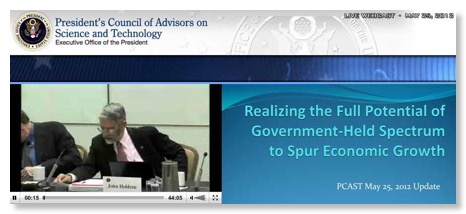
At its May 25th meeting the President’s Council of Advisors on Science and Technology, a White House advisory committee of top technical experts, endorsed a report from a subcommittee entitled “Realizing the Full Potential of Government-Held Spectrum to Spur Economic Growth”. The text of of the report has not been released to the public pending final editing and delivery to the President. However, there was a presentation at the PCAST meeting and below are two “slides” from the presentation.
The first slide to be discussed is below:
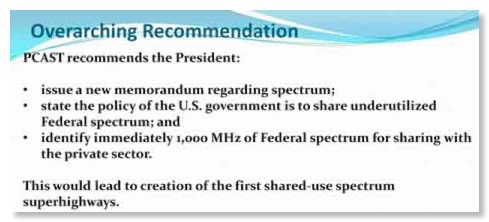
Its second point is to “state the policy of the U.S. government is to share underutilized spectrum”. It is pretty clear that that is not the present policy. I recall that during the drafting of the Spectrum Policy Task Force Report the NTIA staff had a temper tantrum on even mentioning that “interruptible spectrum” sharing of low average utilization federal spectrum might be considered. All reference to the topic in the context of federal spectrum was scribed from the report!
IRAC traditionalists will also not be very pleased with the 3rd point on sharing 1000 MHz with the private sector. I hope the report indicates that this can not be resolved by sharing 97-98 GHz!
Clay T. "Tom" Whitehead

The report recommends creating a “White House-based Spectrum Management Team” of senior Administration officials to work with NTIA. This would be a move in the right direction to give real Silicon Vally-style “adult supervision” to IRAC - the group that makes most spectrum management decisions without much accountability to anyone.
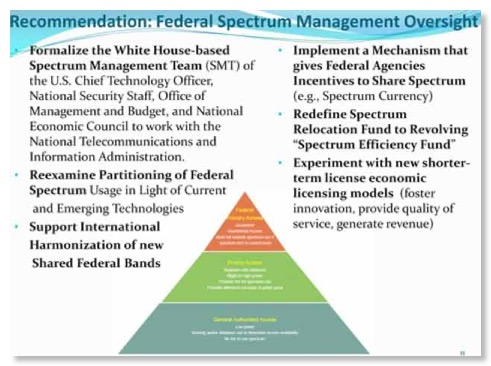
The report also recognizes the at present agencies have no incentive to cooperate with sharing and to be early adopters of sharing concepts. Thus it proposes to reward such early adopters in the budget process.
The report seems very promising and we look forward to seeing the actual text. Hopefully it won’t get lost in election year politics.

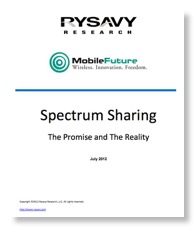



![Validate my RSS feed [Valid RSS]](valid-rss-rogers.png)

